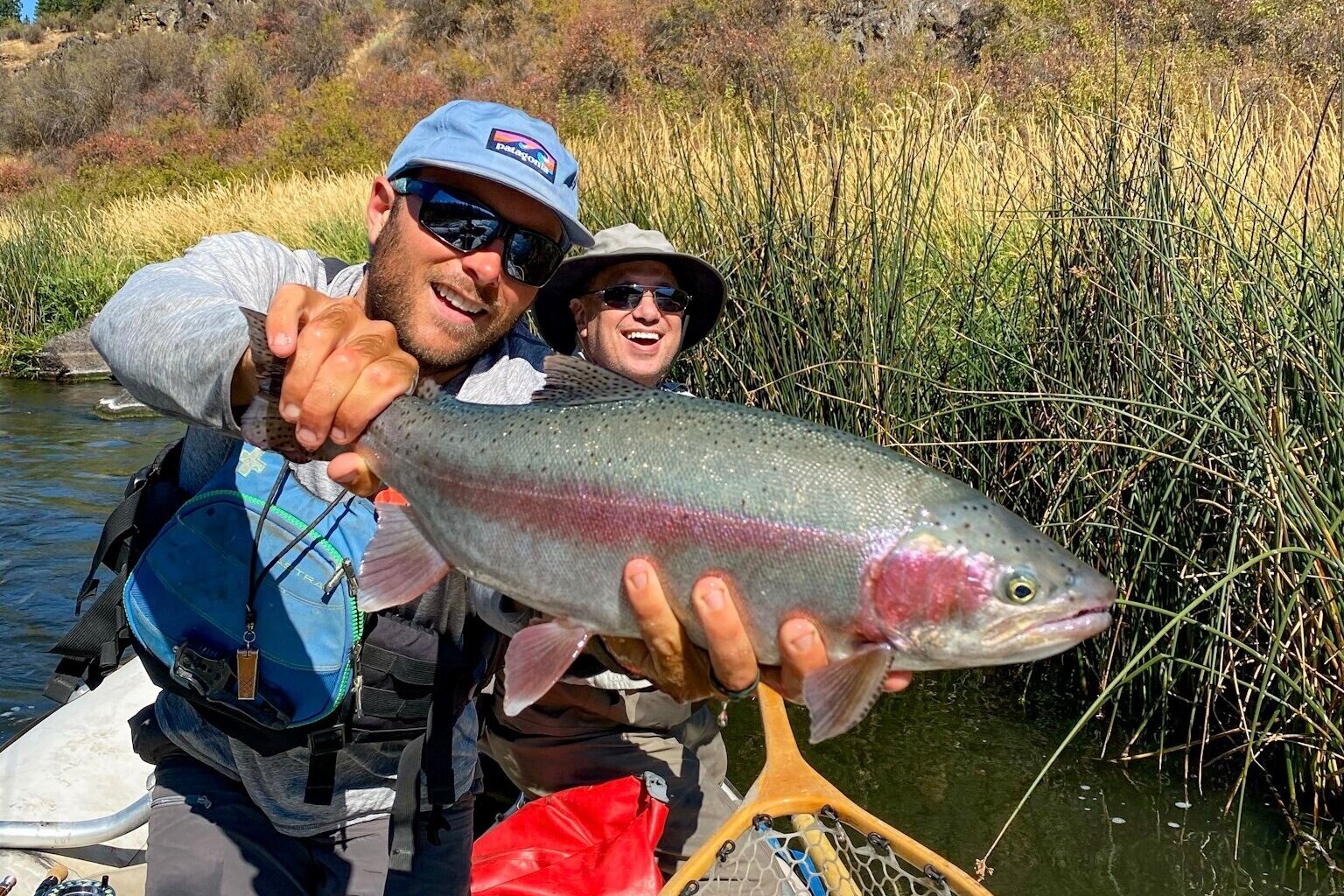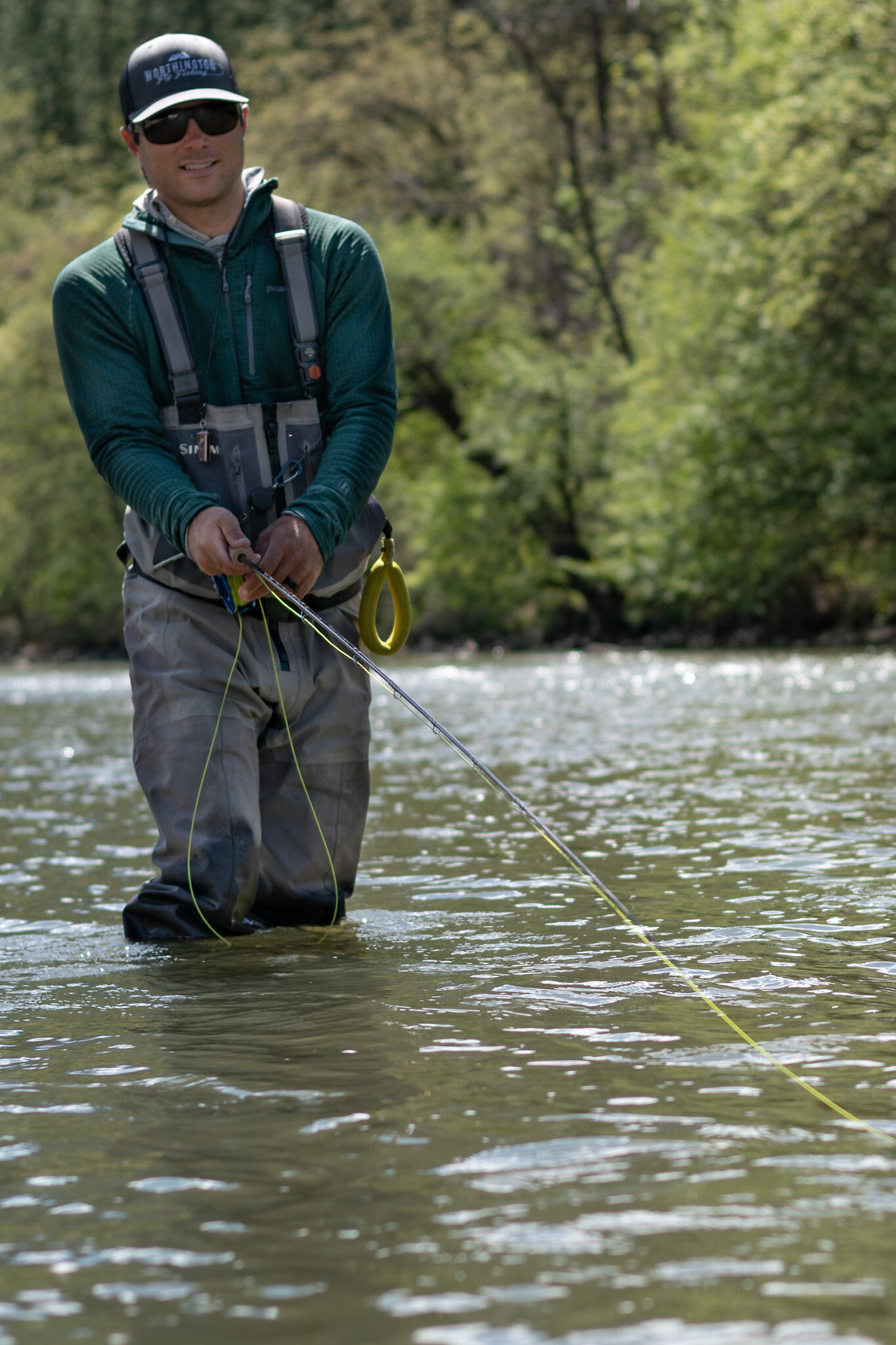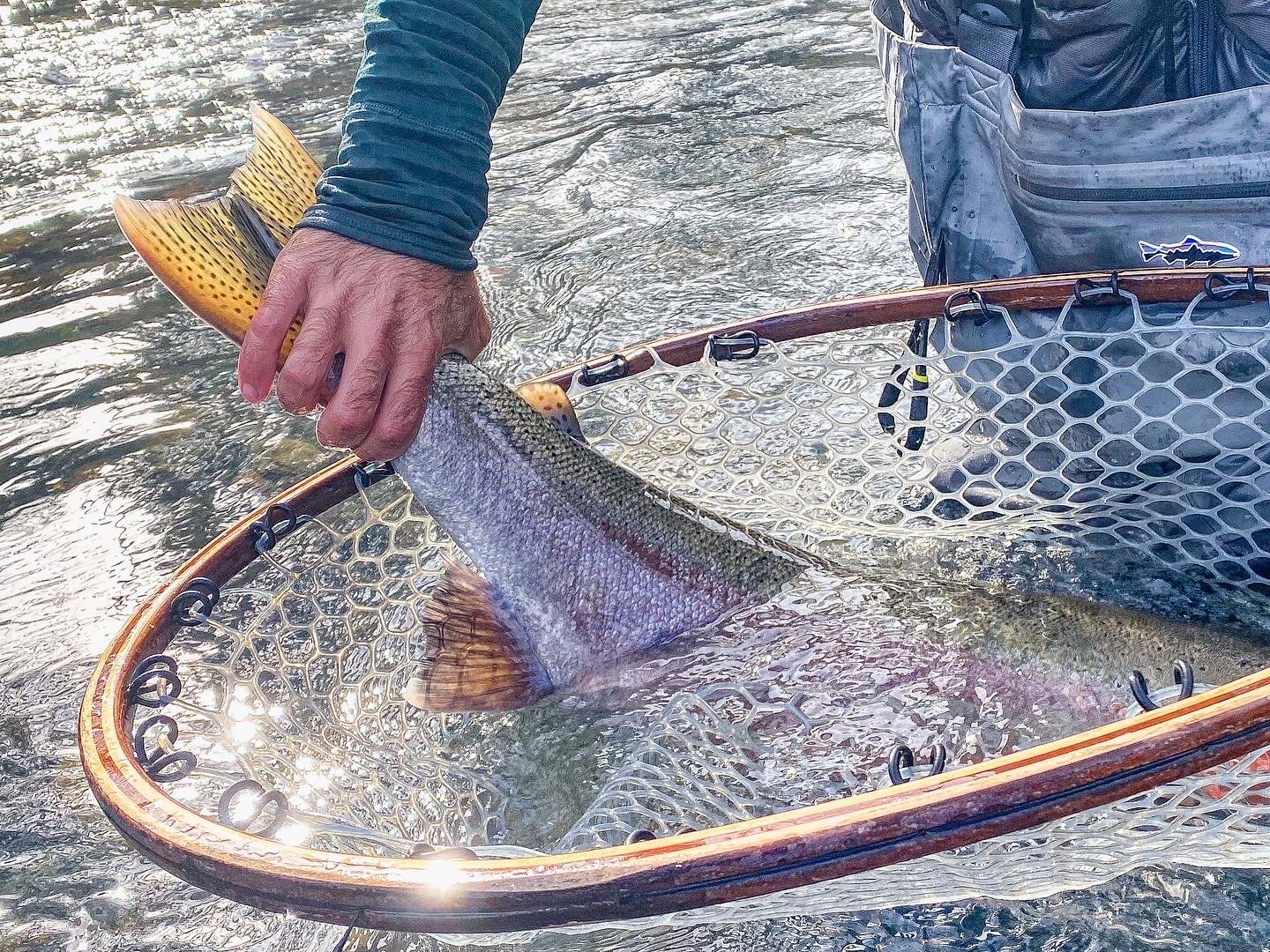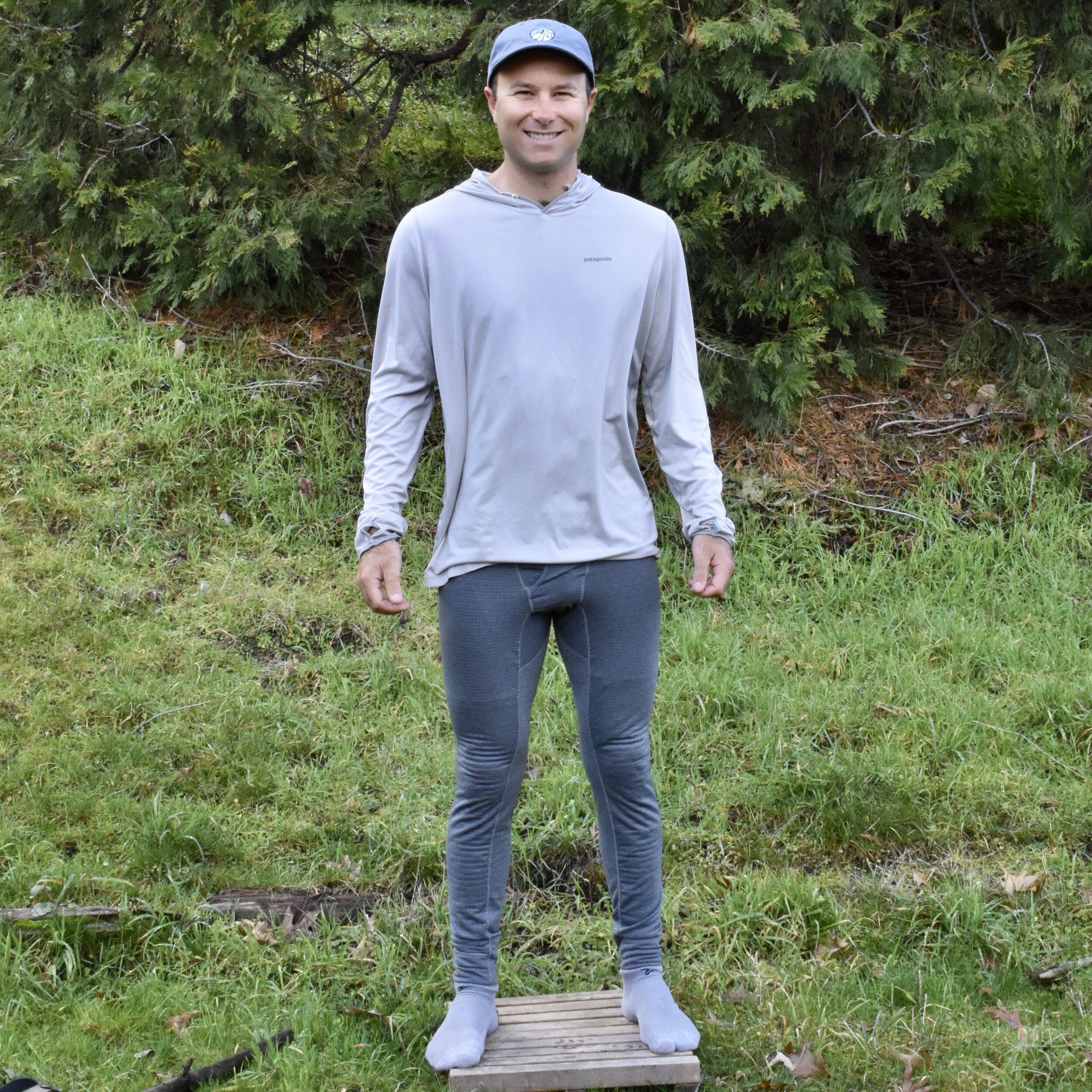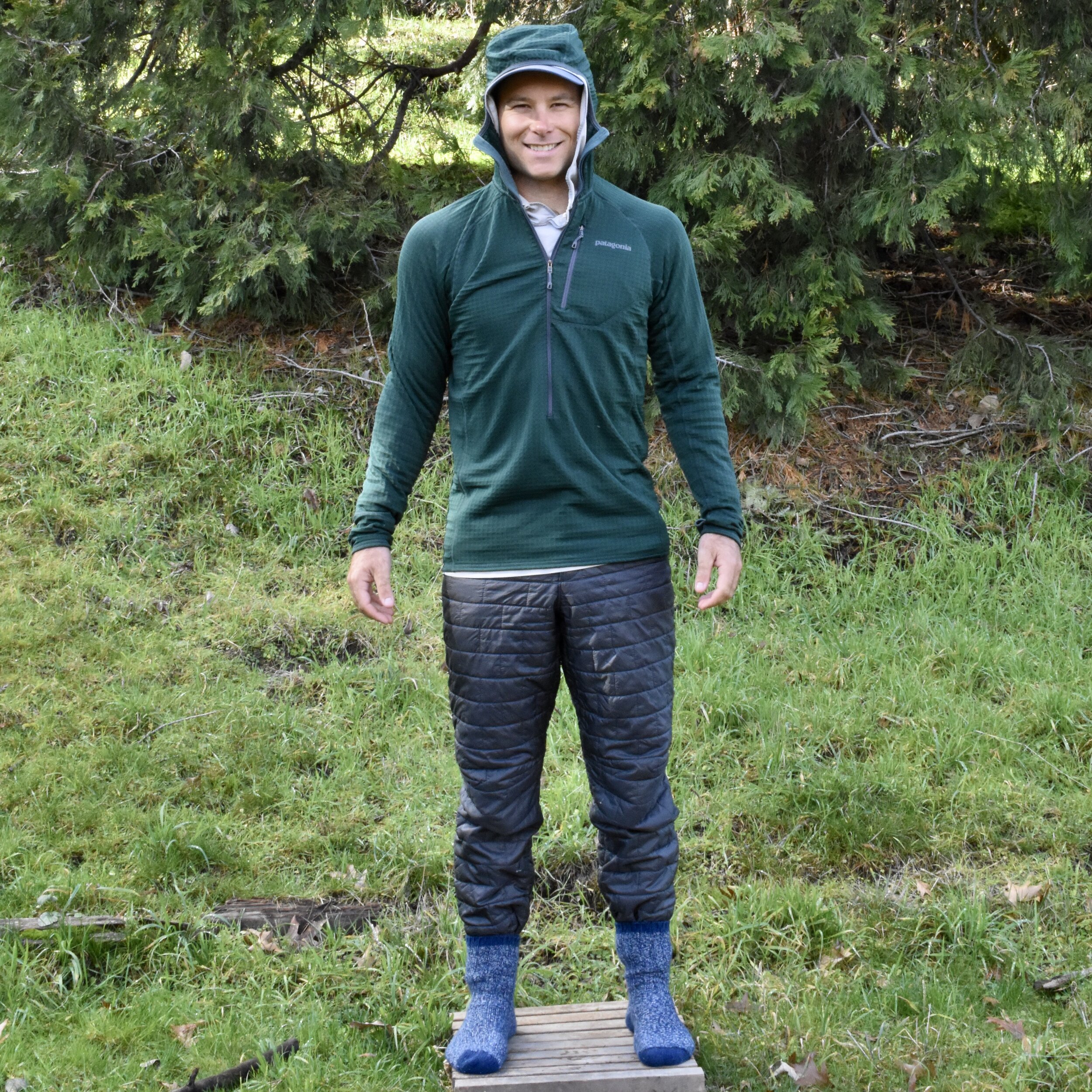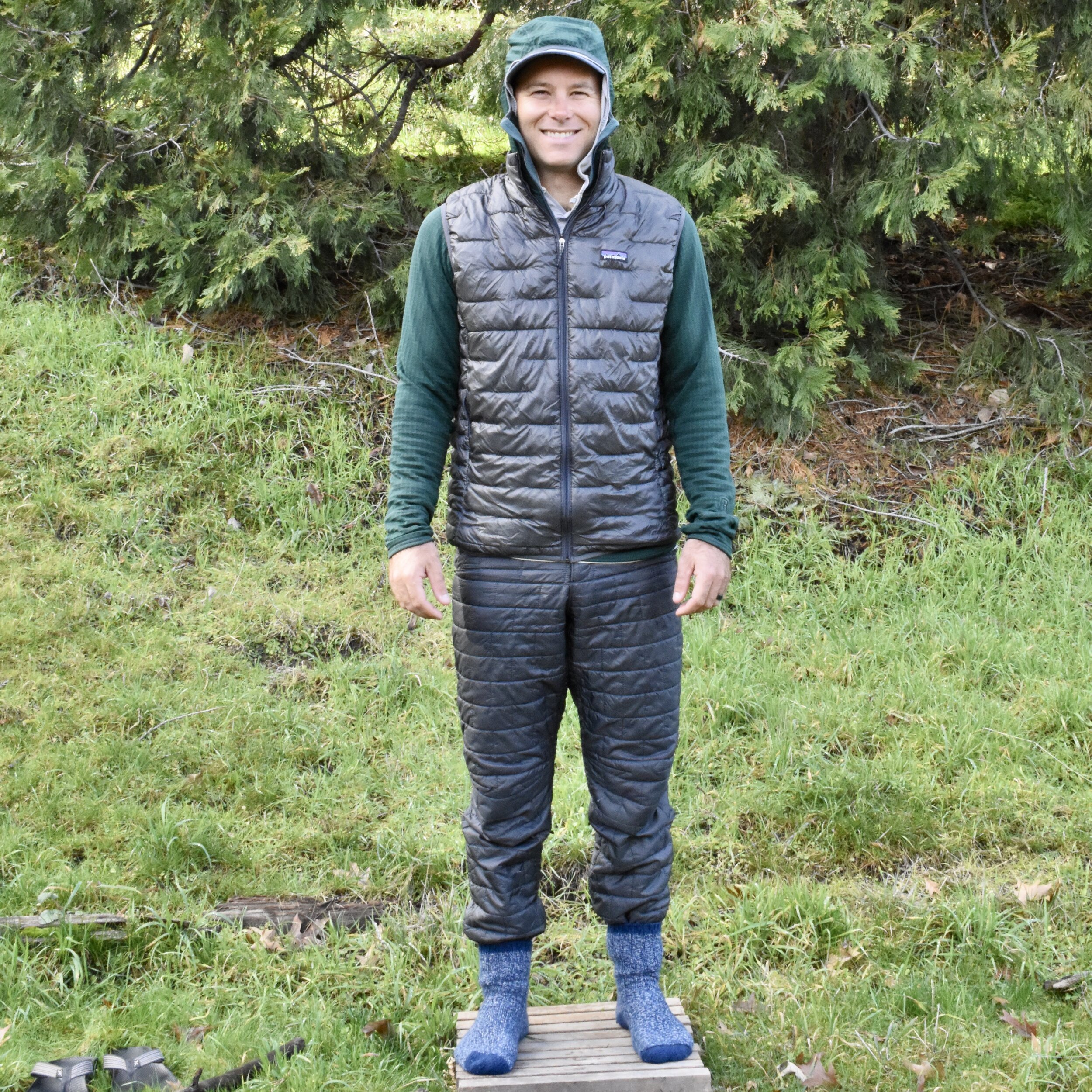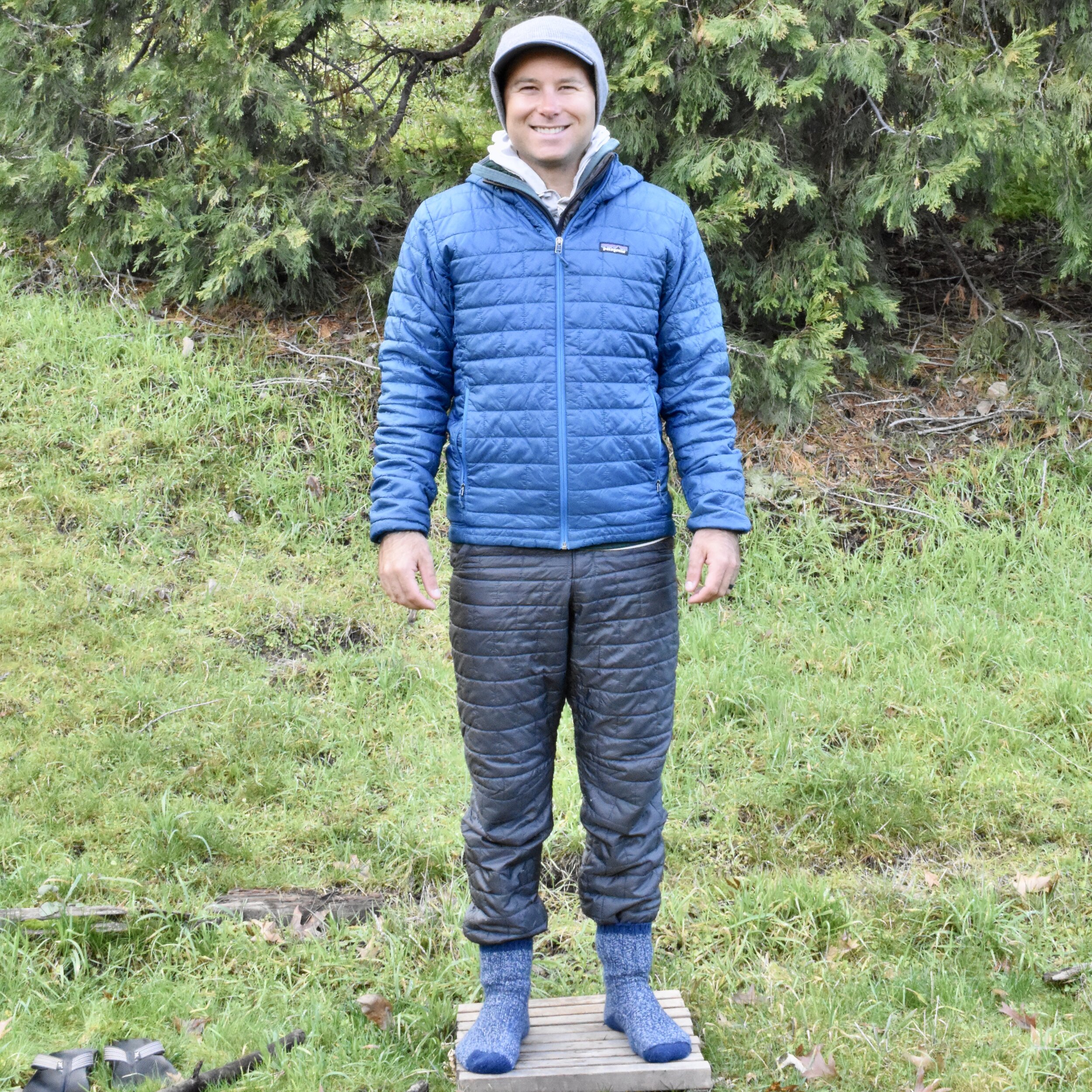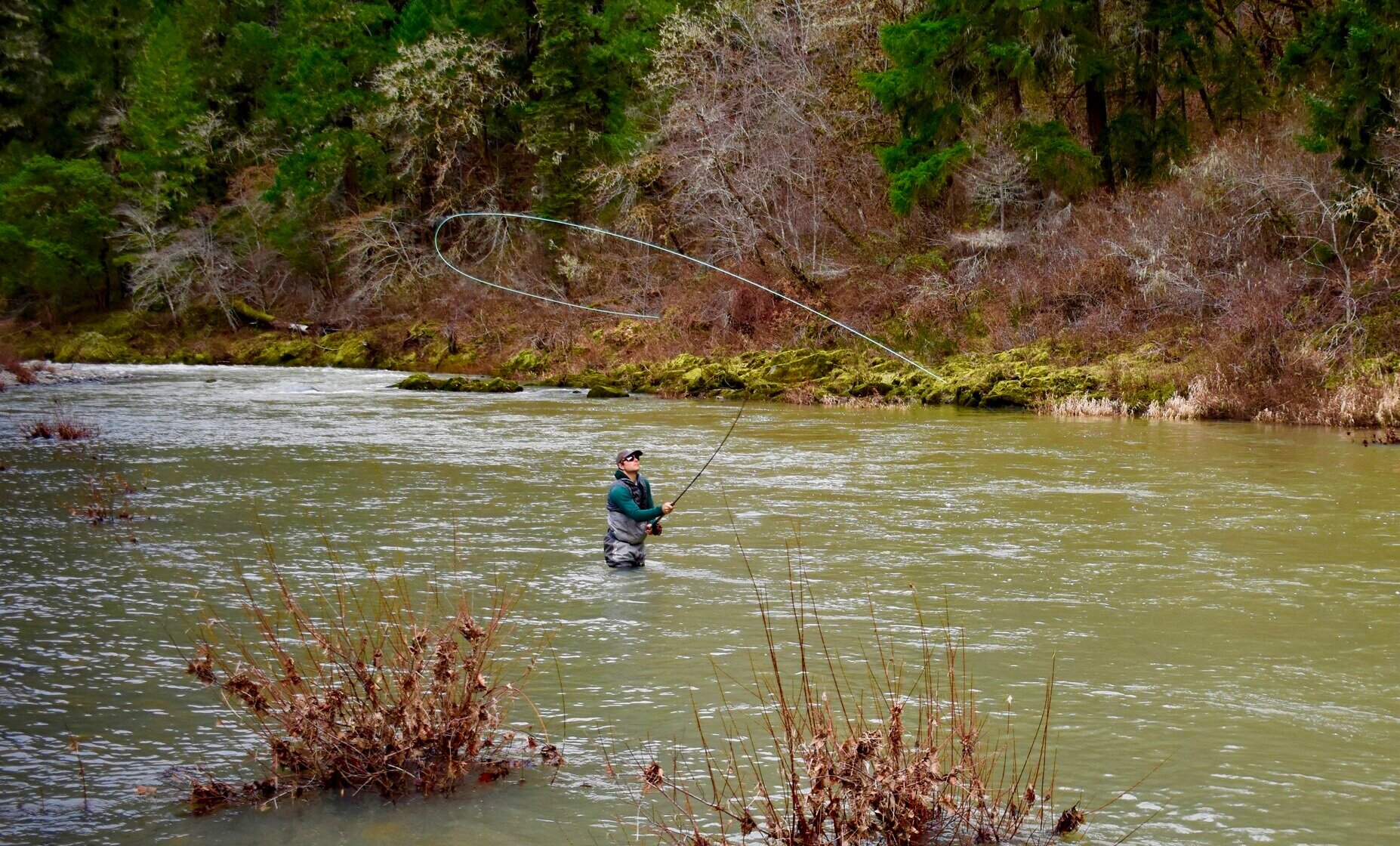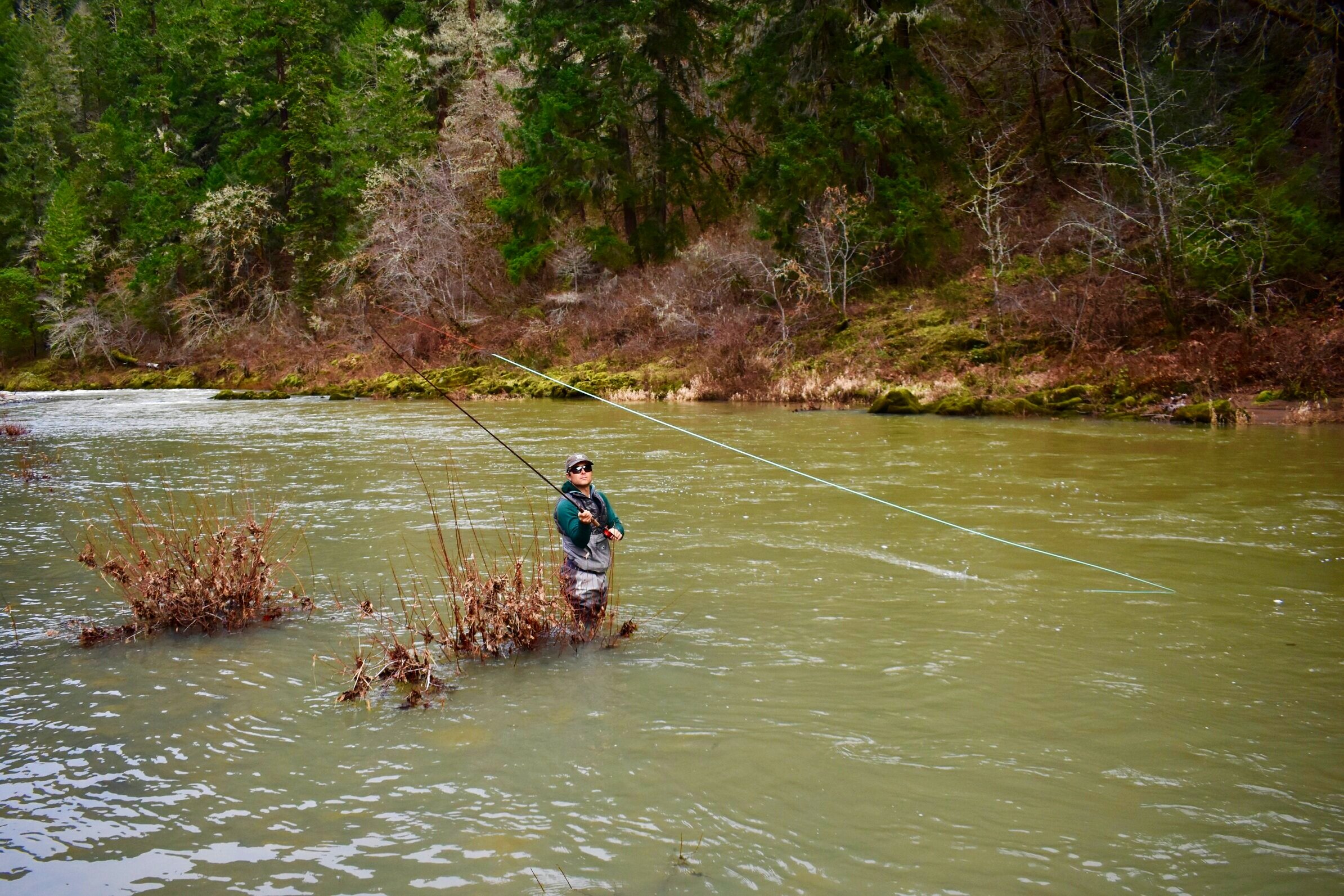Thrilled to be part of the largest dam removal in US history and helping along the vision of a post dam Klamath River!
Klamath Dam Removal: FERC issues draft EIS!
We’re one step closer to seeing 4 problematic dams on the Klamath River removed. Take a read of the full draft EIS!
How to fit wading boots for cold water wading
I see too often anglers not happy with the fit of their boots. There is really only one top consideration when sizing wading boots, and i’m hoping this tangent can help you find the perfect fit.
Thought one: Go big!
Wading is not a performance fit activity so you don’t need the boot to fit that way. You won’t need to be edging on your big toe like rock climbing, running, jumping, or anything like that. Plod, shuffle, slop is more like it . You’ll be in them all day so go big, your feet will thank you!
Thought two: Always jump up a size. At least!
If you are a 10 or 10.5, go with an 11. At least. You’ll be wearing a light sock, your neoprene booties, maybe thick sock stuffed in there too, so you need a little extra room to get it all in there uncrammed. The space is taken up fast. If it’s a little loose when its just a light sock and waders, tighten the laces a little. Or wear bigger socks…or just be okay with a roomy fit. Trust me, it’s better than too small.
Thought three: Special considerations for cold water wading…
Go even bigger!
The absolute worst is not having enough room for your thick socks. In cold water, constriction is your enemy!
As a guide, I have 2 boots to solve my wading issues. A summer boot, which I upsize 1 and a winter boot, which I Upsize 2. If I could only have one though, I’d go with the bigger one. It’s a little loose when I’m not wearing much on my feet, (like summer wed wading with just my neoprene booties) but a small price to pay compared to a day of cold feet.
In order to keep your feet toasty warm you need loft; , Just as a down jacket won’t work when it’s squeezed flat, neither will those high pile wool socks. My winter system is to have a wool sock and a fleece over sock, and to fit all this high pile stuff in the boot, you have to go big.
Last thought: Loose laces
Another fit mistake I see is people lacing their boots too tight. Again, you do not need a performance fit for lobbing flies out of a drift boat or even stepping down a run. Tightne your boots so they stay on your feet, but keep ‘EM loose, so you can wiggle your toes, stay toasty and fish longer, happier
just my 2 cents…
Worthington Fly Fishing Bonefishing Trip & Winter Steelhead
Brandon Just got back from a great week Bonefishing in Southern Yucutan with good friend and client Ryan Tuck. Now back state side Worthington Fly fishing is busy guiding the winter steelhead waters of southern Oregon…
Ashland, Oregon Fly Fishing Trips
Klamath River Update
The Klamath river has been in the news of late. Dam removal, imperiled fish, drought and the socio-political-environmental convergence here are launching the Klamath into the spotlight as it hasn’t been in 20 years.
In 2001, the Klamath faced a similar water predicament as it does today. Three competing interests for water, then, as now. They are:
Lake elevation for endangered suckers
Irrigation water for nearby agriculture
Consistent and healthy flows for endangered Salmon below Irongate Dam
Drought years in the Klamath basin typically mean water scarcity and friction between the three interests. 2021 is no different. The scarcity usually translates into only two of the three interests having their way. Winners and losers. It’s decided after much politicing and stakeholder wrangling, federal, state and private.
In 2001, after water allocation was all decided, the irrigation canal spigots were turned off so Upper Klamath Lake could maintain minimum elevation for suckers and to allow sufficient flows for Salmon down stream.
However, this verdict was not to last and then Vice President Dick Cheney visited the Klamath and arranged for the irrigators to receive a water delivery at the expense of tribes and fish. The lower river did not receive adequate flow that season and a horrific salmon fish kill ensued.
There is a major difference now, compared to 2021, even though the water allocation conclusion is the same. It is unlikely Dick Cheney will ride in and turn the Irrigators’ spigots back on for the project, so flows should not decrease through the river below the lake this year.
The Lake has barley enough water to maintain minimum elevation. Its debatable if flushing flows could or could not be delivered without detriment to the suckers. Their recruitment has been very low over the last many years in spite of elevations being maintained…
Disease numbers are very high below Irongate Dam this year, and the point of the flushing flows is to dilute the disease concentration which is at its highest when smolt out migrate. No flushes this year will lead to higher infection rates, and lower returns in a few years. However, even if there was some immediate change and a flush occurred, it was due several weeks ago for maximum efficacy. Much of the damage to smolt below Irongate Dam has already been done. Wild populations are much more resilient to disease at least, and the Klamath fish are as wild as it gets. The hatchery salmon stock is gonna have a rough time. No new news there.
It does appear that in-river flows through the canyons and below Irongate dam will be sufficient through the summer and fall. I see little change from normal for the trout reaches. Flows below Irongate should help ward against a dewatered river like in 2001, which greatly contributed to the fish kill event.
This year’s drought again increases the urgency of a swift removal of Boyle, but especially the Copcos and Irongate Dam. They are the primary perpetrators creating disease and algae plaguing the waters below Irongate Dam. Removal will allow cool, spring fed waters originating in the upper canyon reaches where we trout fish and greatly improve water quality down stream. With improved water quality in the lower reaches, flushing flows my no longer be as crucial for anadromous fish and lessen the pinch for water.
I’m still greatly optimistic about the Klamath, it has a very bright future ahead. In spite of the dreadful news for some parts of the river, is still as enchanting as ever in others.
5 Tips for Streamer Fishing
Streamer fishing is fun and effective and can lead to hooking the largest fish in the river. Here’s 5 tips to help along the way!
Choose the Right Fly
You can’t catch a fish with a streamer unless you fish one, so the first step is to simply tie one on! Like all flies in the shop bins, many catch the anglers eye, but most play on just a few major themes. In streamer fishing, you’re eliciting a reactionary response from the fish so they wont scrutinize small details much. Size, color, contrast, flash, weight and movement are big themes. Look at fly profile and have a few patterns with different builds. Some of the most time tested patterns are still highly effective and deserve a few slots of foam; Wooly Buggers, Muddler Minnows & Zonkers are great. Most bait in trout streams are earth tones; tan, olive and brown, often mottled, light on the belly and darker on top ranging from 1-3 inches in size. Black is excellent too, and have a few white flies tucked in the corner as trout are cannibalistic!
Cast Angles Instead of mending
Streamer fishing isn’t just chuck it out there and rip the fly around (although sometimes that works great!) Take to the water with strategy in mind as you would when nymph or dry fly fishing . Find the area where you think a fish would be holding and fish the fly through that likely water. This means picking a target for the fly above or beyond the holding lie as set up, then pulling, swinging or twitching your fly through that zone. Analyze how your fly line laying over the currents between you and your fish will belly the line and anticipate how that belly will pull your fly. The further upstream you cast the less belly will form as the fly comes back between you and your target. The further across you cast the more belly and tension will form on the line and the more “swing” the fly will have. More belly means the fly is riding higher in the water column, has more tension, and typically, is running faster as well.
And don’t mend much either. Mending simply adds a step between the fly hitting the water and when you engage the fly, which is inefficient. Pick your target, pick your angle, slap it in there and get that fly fishing!
Get the fly down
There are two good ways to get your streamers down. Sinking line or floating lines with a leader, heavy fly, or added weight. Most of the time I find using weighted flies and adding weight to my leader is more versatile then sink tip lines because you can add or remove weight quickly and change between methods efficiently. I find leader lengths between 5 and 10 feet tapered to no less then 8lb most useful for most situations. Shorter leaders for smaller water or heavily pocketed water is good while longer leaders allow for more sink. Split shot can be added to get an unweighted fly to sink and to really dredge, add shot to a weighted fly, 3-12 inches up the leader.
Vary your retrieve
A good retrieve is crucial for streamer fishing. The retrieve is how quickly you pull line back in, how long the strip is, and how frequently you pull line. Practice grabbing your line just behind your rod hand, pulling, letting go and grabbing again. No matter the retrieve you are using, you need to be fluid at dropping the line you just pulled and finding it again at your grip hand with very little break. Keep your hands tight and close together for better line control. Trout like all kinds of retrieves, so try different ones until you crack the code. Generally, baitfish swim in little bursts, so a good place to start is with several quick, pulls followed by a very brief pause. Follow up with a few more quick jerky pulls and make sure you fish your fly right into the leader. Many times I’ve been pulling my fly out for the next cast to find a vicious take just as the fly was leaving the water! Those trout just can’t stand a meal getting away! If your initial retrieve doesn’t work, try something different. Sometimes they want it swung, sometimes they want it fast and jerky and still other times a smooth slow retrieve all the way back to the boat.
Steer the fly with your rod tip
Perhaps the easiest way to picture this concept is to go to a pool, tie on a streamer and cast it it out there. Start stripping it back and it will come back in a straight line between where it started and the rod tip. On your next cast, move the rod to the right while stripping, and then back to the left. You’ll notice your streamer chasing your rod tip movement, coming back in an “S” pattern. Use this concept to steer the fly on the retrieve around boulders, seams and through different currents in the river. Expanding on this concept you can interchange rod movement with stripping to further maneuver your fly through the water column. This is really where the training wheels come off in streamer fishing and you have the utmost control over your flies. How deep they are, how fast they move through the water, and what movement the fly shows to the fish is all up to you now.
We offer guided streamer fishing trips May - November on the wild rivers of Southern Oregon and Northern California and base out of Ashland, Oregon. Our trout are aggressive and love to chase, offering a perfect place to learn streamer fishing methods, experience the fun and advance your angling skills.
SAGE SONIC 904-4 guide fly rod review
Every once in a while a new fly rod comes out that stands out to me. There are many, Many great options out there, so it takes some stand out elements for a new stick to be entered into my arsenal of guide rods.
First and foremost, the rods we provide on our guided trips have very distinct applications in mind so all the rods we fish are filtered through that lense. I wanted to add another powerful 4 weight into the lineup for this Summers trout fishing so I gave the Sonic a serious look over, and ultimately, grabbed one. Now, after a few weeks of fishing it, here’s what i’ve found…
First Impressions
It’s a good looking fly rod, classic Sage. Great cork, nice color and thread wraps.
First casting impressions and Lines for the Sonic
It’s a powerful rod, classic Sage. I loaded it up with an Airflo wf 5 and it’s just about right. I could see stepping down a little to a 4.5 for more general applications or for the angler that casts longer distances with smaller dry flies. I could also see running a straight 4 for advanced casters who do not need a lot grains to get the feedback they need for good casting. With a 5 wt line on there, the rod loads up with a short amount of line out the tip and feels really good in the mid range. The 5wt line engages more of the rod to get more power from the blank but doesn’t crush the action at all.
I love this rods power. It’s got a classic Sage progressive taper, meaning the more you lean on it, the more it bends. You can really control this rod and ask it to play up while still having a really nice light rod in hand. It is fast, it is powerful, it might be a little loo much for some novice casters at first, but line it up a little and it’s really sweet. Line it up slows the rod down a bit too which will suit most anglers out there. You’ll stil get excellent recovery but with all the line speed, accuracy and crispness.
Price and Value
This rod reminds me a whole lot of the Sage ONE. Which is not a bad thing. But at nearly half the price. It features the same Konnetic Technology as the ONE and other Sage Rods I have in the quiver. I’ve found Konnetic Tech rods break less then some others which is huge plus for me. Keeping sticks on the water and out of the penalty box is super important. I think in the last 5 years I’ve only had a Konnetic rod break once.
What I’ve fished on it
Mostly dry dropper and even dry-dropper-dropper. I fished some indo rigs and have even had a chance to use it for a few dry fly sessions when our Native Redbands were sipping BWO duns. The Rod shines in all of these applications. It was super accurate for the dry fly fishing and delivered nice, snappy mends once your flys were on the water. There is plenty of power in the rod to push the boundaries of fly size and I did. I tried some Golden Stone drys with large dropper flys pre hatch and the rod had no issues what so ever. You can almost think of this rod as a 4.5 with regards to what it can do. Love it.
Conclusion
It’s a fantastic fast, powerful 4wt from Sage. I expect this rod is going to see tons of use by my clients and be a favorite this spring and summer on our local waters.
Brandon Worthington Presents: Guides eye view of the Upper Klamath dam removal to Long Beach Casting Club
February 25, 2021
Brandon Worthington presents: Guides eye view of the Upper Klamath Dam Removal to Long Beach Casting Club. via ZOOM for their monthly meeting.
An informative, interactive slide show brings you up to date on the current status of the removal of four dams on the Upper Klamath River, why the fish in this wild and scenic river are worth it and what it’s like to guide through the largest river restoration project in U.S. history.
First Steelhead & the Trout Thief
Guest Post Written by Stephen Neal
In Wildness is the Preservation of the World - “Henry David Thoreau"
Cy stood crotch deep in the river, his rod cradled in his hand just above the rivers surface, the tip pointed at his fly. The river’s current carried his steelhead fly at that perfect walking pace down into the dangle, he waited. The first tug telegraphed itself up through the line and rod into his hand, he lingered, letting each grab go unanswered, when the reel began to unwind, he raised his rod and set the hook. Cy and Brandon our guide, both sensed that this was a steelhead with possibility. When the steelhead came out of the water in its bid for freedom, the excitement was palatable.
Cy deftly used the flex of the rod to gently manage his attached water citizen, bringing it to Brandon’s net through the fishes’ aerial acrobatics and water antics. Each leap into the world of oxygen was a thing of splendor, as the water slid off the fish’s sides and fell back into the water, each drop and spray reflected Fall’s afternoon light. The fish was a beauty, a wild buck, a nice first Steelhead, a personal meet with this creature of our earth’s rivers. It was a well-earned reward for his time spent learning new casts, knots, fly selection and line control. Cy’s hookup and landing of that Steelhead, will be a memory I will carry with fondness for the rest of my days. A shared memory of the fulness of life.
Cy and I were in Northern California we were spending the day with Brandon Worthington of Worthington Fly Fishing, swinging flies on the Klamath River to wild steelhead. Mid November, fall was in full bloom, with chimney smoke and a taste of winter in the air. The air temperature was hovering around 40 and the water registered 50 degrees. When the sun shone, we were comfy but when it hid behind a hill or cloud, a chilly quiver would creep down our spines. That cold was forgotten each time that familiar tug telegraphed itself to our casting hand.
Fishing with Brandon was like fishing with a respected friend. There was an ease and grace to his every action, his subtle nature belies his knowledge and skill. A gentile but powerful stroke or deft hand movement put the drift boat in position to take advantage of the current and flow of the river. His instructions on casting or fly placement were on point and timely and matched our skill level and improved our performance. His respect for nature, the river and the fish and preserving and protecting them were spot on, he is in a class with Marty Sheppard when it comes to guiding.
Bridget, Brandon’s wife while not on the river with us, was still present, the meal she prepared for us was first rate and Brandon spoke of her with love, respect, and admiration. They make a good team in managing and operating their guide business. If you are looking for a guide for Northern California or Southern Oregon, he would be an excellent choice. I am not alone in making this recommendation Cy, Jeff, Scott, Bob, and Kevin would back this assessment up.
Fifteen years - The six of us were on our annual trip fishing on the upper-Sacramento. Bob always on the lookout for fishing opportunities had followed up a lead and discovered Worthington Fly Fishing, it paid off well. We were all feeling a bit snake bit on the Sac, this year. For years we had heard stories from Dunsmuir locals about trout rising to October caddis in November after the usual seasonal fishermen had returned home. When Kevin told us that his oldest Son was getting married during our usual outing time, we moved our trip
back to try our hand at catching trout on October caddis in November. What we encountered instead were trout disinclined to take what we were offering. We spent a lot of time trying everything we had in our fly boxes and receiving extraordinarily little in return. So, our time spent fishing with Brandon revied our fishing spirits, that is not to say we did not have fun together on the upper-Sac.
Kevin and I were fishing Sweetbrier while Scott and Jeff were fishing with Brandon, and Cy and Bob waggled their Rods above the water around town. I got skunked, but Kevin caught three on the first run we fished then came up zero on the rest of the water. After about three hours of fruitless casting we headed back to the cabin to warm up and re-access our fishing. After a snack we decided to try the water below the cabin and set out to do so. Now things were about to get interesting.
The evening before Scott had a large rainbow roll on his dry fly at the head of the pool, below a frost burned Elephant Ear plant. As Kevin headed upriver to fish beyond the pool, he told me to not leave the water until I had thrown a dry fly to that same spot. It was not to be, I got a bird’s nest in my line on the next cast and headed back to the garage to sort out the mess I gotten myself into. I hollered at him to fish the spot, but he could not hear me over the river. When Kevin returned to the cabin, he had a fish story to tell and a picture to share. He admonished me for not fishing the spot and shared his picture of a nice hefty rainbow trout neatly wrapped up in Kevin’s line. Kevin was feeling pretty proud of himself and thankful that said fish had neatly wrapped himself up so that Kevin could land it on his light tippet. He politely accepted my excuse of my failed cast and subsequent line tangle but I think inside he was thanking God that my cast has failed and that he got to cast to the fish under the Elephant Ear plant. That would have been the end of that story but there are four other people in this group of fishermen who are about to take this fish story to a new realm.
That evening around the dinner table in the glow of the fireplace and under the influence of a little wine and Scotch, Kevin told his fish story; and Jeff was primed and ready. We had all been told Jeff’s story about how Kevin had stolen his fish 15 years ago, Jeff had hooked a monster and fought it for an eon of time and the fish had come undone and Jeff was left with a broken heart and a parted line. And the next day Kevin fished that same hole and not only hooked that same fish, but he had the audacity to land it. Jeff’s world was undone and for 15 years we have heard this tale told about how Kevin is a Fish Thief. Jeff was sure that he could now remake his case that Kevin was a fish thief, and that Scott would back him up. And as per usual Jeff retold his story of failure and betrayal and for the next forty-five minutes we pontificated, we speculated, and hypothesized about said fishing infractions and laughed uproariously. It was agreed that Jeff, first wore the fish out thereby allowing Kevin to catch it, and that Scott left his fish so disappointed in not taking his fly that it was determined to take the next fly it saw, thereby allowing Kevin to catch it.
Ah the loyalty of fishing friends and the deft hands of light-fingered maestros of rods and fly presentations, will present endless possibilities for mirth and accusations of unfair play for years to come. And so, goes our fishing discussions over diner, scotch, fireside chats, and smoke sessions. Each of us becomes the hero or the goat depending upon whom, is telling the stories. Our banter is just as great today as it was 15 years ago when we started this journey. Good fishing friends are worth their weight in gold and tall tales. I cannot close out this article without mentioning Bob Grace owner of Ted Fay’s in Dunsmuir. Bob and his fly shop are an integral part of the Dunsmuir experience. Please drop in and support Bob when you are in the area.
As always, Thank you Cy, Bob, Kevin, Scott, Jeff and Brandon and Bridget Worthington and Bob Grace of Ted Fay’s, for a wonderful and epic fishing journey in Northern California. Each of you add joy and richness to life.
Stephen
The world is out there, the journey starts the minute you leave the door, go outside and truly live.
“When given the choice between being right or being kind, choose kind – Dr. Wayne W. Dyer
“Many go fishing all their lives, without knowing that it is not fish they are after” - Henry David Thoreau
Fall Steelhead Magic
Fall is a wonderful time to be on the water. The air is crisp, the water cool, the colors bright. The fishing can be pretty darn good too!
Join us for a memorable trip fly fishing the Rogue, Klamath Umpqua and Beyond…
Fishing Headwaters - Following the Klamath River upstream
Fishing small water can be a delightful passtime. I’ve found most known waters worth fly fishing also have many other miles of water worth exploring, offering smaller fish but more intimate experiences. Fishing a river system top to bottom will give you a better understanding of the watershed as a whole and hopefully, a better appreciation for the complex pieces that come together to form our favorite beats. I whole heartedly endorse exploring your favorite waters by following the river upstream as far as it will take you…
How to Make Fly Tying Shanks
Make your own Steelhead or Trout shanks. Easy, cheap, & customizable. Tie your own flies on your own shank.
I started tying shank flies before there were too many commercial options around. So I’ve stuck with it, and made my own for years. These are solid, cheap, easy and oh so versatile. There’s something cool too about the foundation of you swing flies being something you crafted by hand. They’re all that fishier for it!
You’ll Need:
Spinner Forms: These are borrowed from the lure making world and come in a number of lengths. Creative folks can make three shanks per form. Considering most packs are 50 or more, you’ll have a decent supply. I have found these at Sporting goods stores and online retailers. You’re local tackle shop also likely has them, if they exist anymore.
Needle Nose Pliers: Do I need to explain these?
Grinder: I use a hook sharpener, though anything in your shop that fits the bill will work. When you cut the spinner forms, any ragged edges need to be filed down or you risk cutting thread while tying, or having a sharp edge on your fly which could find your line or trailing wire.
Tying Vise
I have found these home made shanks work great for barbell eyed flies if you turn the eye up, and great for unweighted flies if you leave the shank true. If you are really carful and precise with your plier and vise work, I can usually mount a 1/4” bead on too for another weighted fly option.
Happy Tying!
Casting Practice Game
Bored at home because you can’t go fishing? Don’t let social isolation take a hit on your cast! Give this fun fly casting game a try!
Read moreStand Here and Fish
In the not too distant future, we’re going to hit the rivers again. And when we do, you’ll have the best view in the house. Missing sharing our passion with you, we hope to see you soon!
Shaking hands with fish
So they say not to shake hands with people but steelhead are still ok right?!
Cause we’re still shaking hands daily...
So they say not to shake hands with people but steelhead are still ok right?!
Cause we’re still shaking hands daily...
Outstanding riverside lunches you can keep your waders on for!
When fishing with Worthington Fly Fishing, we provide exceptional guiding and outstanding days on the water. We are honored to not only make sure your getting the best action of the season but also a healthy, gourmet lunch! Try not to drool over today’s Mushroom and Tri Tip sandwiches on Bridget’s Grandma’s French Roll recipe!
Wild epitomized
What to Wear: Winter Steelheading
Winter Steelheading is HARD. With colder water temperatures, fish are less active and grabby, some days can get a little frustrating. So, the first thing you need is an optimistic attitude and the last thing you need is to be cold.
Whether you are drifting from the boat huddled up around a small propane heater or waist deep rocketing your favorite intruder across a 35 degree river, Winter Steelheading can be FLIPPING COLD. Some days there’s a gnarly wind-chill, some days its dumping snow, while others are perfectly glorious, sun-filled days or a mix of all the above. We find that it’s best to be prepared for everything to ensure that your awesome day on the water isn’t ruined or even ended early due to poor clothing choices. So, we’re going head to toe, helping you stay warm this Winter Steelheading season!
Before we get too far, LAYERS. We can’t stress it enough. The worst thing that can happen is you bring too many and have to take some off. That’s not a problem, being too cold is, so here’s a layering system we use.
Layer 1
- Standard ball cap (WITHOUT a mesh back).
- Long-sleeved base layer (preferably something quick-drying as we tend to get our sleeves wet when we catch fish). A hoody that is quick-drying can be worn year round and is a perfect sunshade in the summer!
- Midweight long-johns/leggings/base layer with a tapered ankle.
- A thin sock. A running sock works great.
Layer 2
- Active fleece hoody. Bridget’s is a full-zip hoodie that was on sale at REI.
- Pant insulation layer. This can vary based on your warmth tolerance and your budget. Our number one choice for this is an insulated pant, these are a complete gamechanger when it comes to Bridget’s fortitude for winter fishing, camping and hiking. The next option we would go with is a thick fleece or fleece-lined pant. Sweatpants work in a pinch.
- Next is a nice fluffy wool sock. Be sure to tuck your pant hems into the outer sock and smooth it out as best you can. Otherwise, it might bunch and ride up when you pull on your waders!
Layer 3
- Insulated vest. These are great for someone who is going to be fairly active while out in the cold, keeping your core warm while your arms are busy catching all the steelhead!
- Brandon finds a vest indespensible nearly year round. They are great for nippy mornings in the fall and spring and because they provide core insulation only it allows for better heat regulation for the hike in, the row out, and the deep wade.
Layer 4
- Beanie that can stretch around your ball cap.
- Insulated jacket. This should really be a requirement to get on the boat in the winter.
- This is your puffy layer, or insulation layer and can be a number of different pieces including a high pile fleece, a down jacket, a synthetic puffy or even a shell with built in insulation.
Layer 5
- Waders. This is not the time of year to bring out your old beat to the curb waders. Your day could be ruined with the slightest pinhole in the wrong place. Make sure you’re all patched up before your big trip. Also, cold feet can make your whole body cold and could very well be the most important and difficult part to figure out, but I think we’ve got it down. To start, you need to make sure that your wading boots have ample room to fit your feet, enough sock insulation to keep you warm, and your wader sock. We like to go up a size in boots for this exact reason. Yes, that means that in the summer time when we’re wet wading our boots are a touch big but that’s nothing when compared to frostbitten toes.
Layer 6
- Rain jacket. Keep all the precipitation and wind out while trapping all your yummy warmth in. This one is an absolute must for Winter Steelheading. Even if you looked at the weather report and they are promising sunshine and glory, it’s still the PACIFIC NORTHWEST. Bring a rain jacket. Sometimes the wind-chill can really surprise you.
- Gloves. This one is more preference. Some people hate managing line with gloves on but we always recommend bringing a pair or even two of your favorite gloves. Bridget will guaranteed within 1 hour get her gloves wet and Brandon will have to dig out his spare pair. If you tend to get very cold hands, it might be a good idea to bring some hand warmers too.
Now, this is what we typically wear from December through March in Southern Oregon and Northern California. But every trip we go on we bring a dry bag with the following essentials, just in case:
- Cozy, large fleece/sweatshirt
- Sweatpants
- Extra gloves
- Extra beanie
- Extra wool socks
- Wool buff/scarf
We hope this helps keep you warm while pursuing the elusive Winter Steelhead. Their an unforgettable catch and we would hate for you to miss out on their glory because you were too cold.
If you’re interested in a Winter Steelhead trip with us, check out this page and contact us here.
Good luck and tight lines,
Brandon and Bridget
Use your eyes for better spey casting
Many spey casting issues can be remedied with one simple fix and the use of a tool we all have, but don’t use often enough.
So when I’m guiding spey clients, where casting is a big component of the game, I try and distill casting down to its fundamental components, use a simple toolbox to fix problems, and ensure we can spend less time farting around casting, and more time actually fishing.
We know (or should know!) that good casting leads to more opportunities on the water, yet it’s still too easy to lose sight of our casting, which can lead to a whole host of issues, including blown anchors, speed and d-loop problems and trajectory mishaps.
So have you figured out what tool to use?
Yes, it’s, your eyeballs! And using them to watch what the heck is going on in your cast from start to finish is where every caster should begin to solve many of the casting problem they are having.
I see all too often, even from good anglers, poor casts are the product of a lack of observation throughout the casting stoke. They’ll set an anchor, form a d-loop, apply power to the forward stroke, and do it all blind, expecting a lazer-dart cast to fire off their rod tip into the abyss.
It works like that for some people, but not most of us, so here’s some simple ways to apply your eyeballs to your casting for better and more consistent results.
1) Watch your rod tip
Train your eyes here from the very beginning of your cast until the end. It might take a few tries to keep your eyes trained the whole time, so you can include the junction of your running line and shooting head too. The point is stay with your cast, all the way through, start to finish.
2) Open up your stance
If you are having trouble staying with your tip throughout the cast, try pointing your toes a little more downstream so your shoulders don’t get in the way and you are facing more of your d-loop. If your shoulder is getting in the way of watching your cast, you’re likely over rotating! Good casters look like they are hardly doing anything at all, and you should strive for that too.
3) Head Up
And keep your head on a swivel. In just about all spey casts, there are multiple directions involved, and you are going to have to move your head to stay with your cast and execute it. Allow your head to move as you cast, to follow your rod tip, observe your d-loop and pick a target for the forward cast. It will help your timing immensely, and even save a bad cast. By watching it all we’ll often catch the error mid stroke and can make a real time correction. Keeping your head on a swivel will also save you from annoying issues like catching your d-loop in the trees behind you. Why? Because you were watching it and saw it was about to go in there!
So watch your rod tip, open your eyes, and enjoy throwing some beautiful wedges out there!






